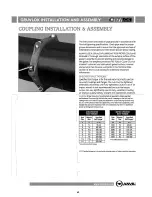
59
GR-82E2
PUMP AND SEAL DISASSEMBLY
AND REASSEMBLY
Seal Reassembly and Installation
continued
(Figures 1 and 3)
Sub assemble the inboard stationary seat, packing
ring and stationary washer. Press this unit into the
lubricated seal liner until the seal faces contact.
A push tube cut from a length of plastic pipe or deep
socket would aid in this installation. The I.D. of the
tube or socket should be approximately the same
size as the I.D. of the seal spring.
Slide the spacer sleeve onto the shaft until it seats
against the inboard rotating element and install the
seal spring.
Sub assemble the outboard stationary seat, packing
ring and stationary washer. Press this unit into the
lubricated seal liner. Install the outboard rotating
element with the chamfered side toward the impeller.
Lubricate the seal assembly as indicated in
LUBRICATION
after the impeller has been installed.
Impeller Installation
Inspect the impeller and replace it if cracked or
badly worn.
The shaft and impeller threads must be
completely clean before reinstalling the impeller.
Even the slightest amount of dirt on the threads
can cause the impeller to seize to the shaft,
making future removal difficult or impossible
without damage to the impeller or shaft.
Install the same thickness of impeller shims (7) as
previously removed and screw the impeller onto the
shaft until tight. Bump the impeller tight with a wood
block or soft mallet.
The clearance between the back of the
impeller and the seal plate should be
between 0.010 and 0.020 inch
(0,25 to 0,51 mm).
Measure this clearance and add or remove shims
from the impeller adjusting shim set until the correct
clearance is achieved.
Pump Casing and Wear Plate Installation
If the wear plate assembly (9) was removed,
install the new wear plate in the pump casing and
secure it with the hardware (2 & 13).
Install a new set of casing gaskets (5) and slide the
pump casing over the impeller and against the
gaskets.
The clearance between the face of the
impeller and the wear plate should be
between .010 and .020 inch
(0,25 to 0,51 mm).
Remove gaskets from the gasket set until the correct
clearance is achieved. Secure the pump casing to
the seal plate with nuts & lock washers (2).
Suction Check Valve Installation
Inspect the check valve components and replace
them as required. Sub assemble the check valve
weights and gasket using the attaching hardware
(14, 15, 16, 17).
Install the check valve assembly on to the studs
(11). Large weight toward the pump casing.
Replace the suction flange onto the studs (11), and
secure with the nuts (2).
Check the operation of the check valve to ensure
proper seating and free movement.
Final Pump Reassembly
Be sure all hardware and drain plugs are tight, and
that the pump is secure to the base and power
source.
Install the suction and discharge lines / hoses and
open all valves. Make certain that all piping
connections are tight, and that the weight of the hose
is independently supported and secure.
Before starting the pump, fill the pump casing with
clean liquid.
Apply Pipe Sealant or equivalent compound to the
fill plug (19). Reinstall and tighten the fill plug.
Refer back to OPERATION, before putting the
pump back into service.
Summary of Contents for M2-H
Page 2: ...2 This page left blank intentionally ...
Page 13: ...13 ...
Page 18: ...18 M2 H Identifying Your Machine Components Location of Tags and PIN Plates ...
Page 19: ...19 SECTION II Description Care and Maintenance ...
Page 31: ...31 SECTION III Set up and Installation of Unit in Detail ...
Page 33: ...33 SECTION IV Operating the M2 Unit ...
Page 41: ...41 SECTION V Troubleshooting the M2 Unit ...
Page 44: ...44 SECTION VI Periodic Maintenance Repair Information ...
Page 49: ...49 SECTION VII OEM Repair Information ...
Page 62: ...62 ...
Page 63: ...63 ...
Page 64: ...64 ...
Page 68: ...68 SECTION VIII Parts Manual ...













































